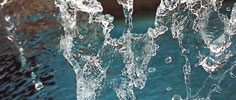

Turck Industrial Automation White Paper.
The International Electrotechnical Commission (IEC) established a classification system to rate the degree to which the enclosures of electrical components are sealed against the intrusion of foreign bodies such as dust and moisture. This classification system implies various degrees of ingress protection, and is indicated by the letters IP followed by two digits. The first digit represents the degree of protection afforded against solid objects, while the second numeral signifies the degree of protection provided from the ingress of water.
Ingress protection ratings were established to create uniform performance requirements of electronic enclosures intended for specific environments. These guidelines describe in general how an electronic device will function in a particular environment, however, these ratings do not ensure how a device functions when outside variables are introduced.
Proximity sensors and other electronic sensing devices are typically rated between IP65 and IP69K. In this case, the 6 indicates that the equipment is dusttight, while the second digit rates the amount of water ingress allowed as indicated below:
* IP65: Protected against low-pressure jets from all directions for one minute with limited ingress permitted.
* IP66: protected against direct sprays from all directions for one minute with limited ingress permitted.
* IP67: Protected against the effects of immersion from 15 cm to 1 m for 30 minutes without water ingress.
* IP68: Protected against complete continuous submersion in water without water ingress under conditions that are specified by themanufacturer.
* IP69K: Protection against hot steam jet cleaning per EN 60529 and DIN 40050-9. This provides protection against water pressure rated at 100 bar at a temperature of 80°C. The pressure is applied directly to the sensor in 30° angle increments (0, 30, 60 and 90°) for 30 seconds at each point for a total of 120 seconds (two minutes without water ingress).
These ratings are often misunderstood and misapplied by the user. For example, many users assume that a rating of IP67 or IP68 allows a device to function while under water for the time specified per IP rating. This is not the case, as the rating only ensures that the device will function properly after it is removed from the water.
Another misconception is that an ingress protection rating of IP69K automatically complies with IP67 and IP68. IP69K protects against pressure and jet spray, but the device may not be suitable in applications where it is immersed in water. Therefore IP69K rated devices are often used in wash-down environments, such as those found in breweries, carwash and food and beverage applications, but not in applications where the device is immersed in water. To be rated IP68, a device must meet the requirements of IP67; however, the company that produces the component determines what additional ingress protection the device contains for the IP68 rating. The manufacturer also determines if there are temperature constraints on these specifications, as temperature fluctuations are known to affect the capability of electrical devices to function properly.
Since manufacturers make these determinations independently, some produce components that meet the minimum requirements of IP68 specifications, while others far exceed these requirements. Turck, for instance, requires that its proximity sensors meet the following specifications in order to be classified as IP68:
* IP67 protection.
* Seven days submerged in water at 1 m (constant temperature).
* 24 hours at 70°C.
* 24 hours at -25°C.
* 10 cycles of temperature fluctuation between -25°C and 70°C with a minimum of 1 hour at each temperature.
Other manufacturers that do not have such extensive requirements can still classify their sensors as IP68 because the device exceeds a rating of IP67 (ie, the sensor withstands immersion in water for four hours at a constant temperature). This can lead to comparisons between products that are not always accurate, and the misuse of sensors.
For more information contact Rodney Topham, RET Automation Controls, +27 (0)11 453 2468, [email protected], www.retautomation.com
| Tel: | +27 11 453 2468 |
| Email: | [email protected] |
| www: | www.turckbanner.co.za |
| Articles: | More information and articles about Turck Banner Southern Africa |

© Technews Publishing (Pty) Ltd | All Rights Reserved